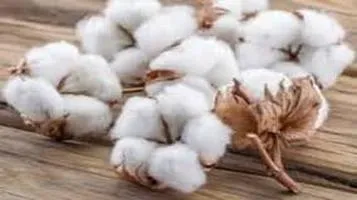Cotton: The King of Natural Fibers
Cotton is a soft, fluffy staple fiber that grows in a protective case around the seeds of cotton plants, which are native to tropical and subtropical regions worldwide, including the Americas, Africa, and India. Known for its versatility, cotton is primarily used in textile production, offering breathability and comfort in clothing and bedding. The fiber is composed of cellulose, an organic compound that makes it strong and absorbent, ideal for various applications. Cotton cultivation has significant economic importance, providing livelihoods to millions globally. However, it also poses environmental challenges due to water usage and pesticide application. Innovations in sustainable farming practices aim to address these concerns, ensuring that cotton remains a vital resource in the textile industry.

Cotton, often referred to as "the fabric of our lives," has an illustrious history and an ever-present role in the textile industry. Its versatility, comfort, and sustainability make it a preferred choice for various applications, from clothing and home furnishings to industrial products. This review delves into the multifaceted nature of cotton, exploring its historical significance, cultivation, processing, applications, and environmental impact.
Historical Significance
Cotton has been cultivated for thousands of years, with evidence of its use dating back to ancient civilizations in India, Egypt, and the Americas. The domestication of cotton significantly impacted these societies, facilitating the development of intricate textiles and boosting trade. The cotton gin, invented by Eli Whitney in 1793, revolutionized cotton processing by making it easier to separate seeds from fibers, leading to a boom in cotton production and its entrenchment in the global economy.
Cultivation and Harvesting
Cotton is a soft, fluffy staple fiber that grows in a boll around the seeds of cotton plants, which belong to the genus Gossypium. The primary species cultivated for commercial purposes are Gossypium hirsutum and Gossypium barbadense. Cotton plants thrive in warm climates with adequate rainfall or irrigation, making regions such as the southern United States, China, India, and Brazil major producers.
Cultivating cotton involves several stages: planting, growing, flowering, and boll development. Modern agricultural techniques, including the use of genetically modified (GM) cotton, have improved yields and resistance to pests. However, cotton farming can be water-intensive and relies heavily on pesticides, raising concerns about its environmental impact.
Processing Cotton
Once harvested, cotton undergoes several processing steps to transform it into usable fiber. The journey begins with ginning, where the cotton lint is separated from seeds and debris. The cleaned lint is then spun into yarn through a series of mechanical processes, including carding, combing, and drawing. The yarn is woven or knitted into fabric, which is then dyed and finished to produce the final textile product.
Advancements in technology have enhanced the efficiency and quality of cotton processing. For instance, high-speed spinning and weaving machines enable mass production, while modern dyeing techniques offer a vast array of colors and patterns. Additionally, cotton can be blended with other fibers, such as polyester or elastane, to enhance its properties.
Applications of Cotton
Cotton’s versatility is evident in its wide range of applications. In the realm of clothing, cotton is prized for its softness, breathability, and hypoallergenic properties. It is a staple in everyday wear, including t-shirts, jeans, underwear, and activewear. Cotton’s ability to absorb moisture and regulate body temperature makes it ideal for warm-weather clothing.
Beyond apparel, cotton is essential in home furnishings. It is used in bedding, towels, curtains, and upholstery due to its durability and comfort. The fiber’s absorbent nature also makes it suitable for medical supplies, such as bandages and swabs.
In the industrial sector, cotton finds applications in products like tarpaulins, conveyor belts, and eco-friendly packaging. Its biodegradability and renewable nature position it as a sustainable alternative to synthetic fibers in various contexts.
Environmental Impact and Sustainability
Cotton’s environmental footprint has been a topic of debate. Conventional cotton farming is resource-intensive, particularly in terms of water and pesticide use. The over-reliance on chemical inputs has led to soil degradation, water pollution, and adverse health effects on farmworkers and surrounding communities. Additionally, cotton cultivation can contribute to deforestation and habitat loss in certain regions.
In response to these challenges, sustainable cotton initiatives have emerged. Organic cotton farming, which eschews synthetic pesticides and fertilizers, has gained traction. Certification programs, such as the Global Organic Textile Standard (GOTS) and Better Cotton Initiative (BCI), promote environmentally friendly and socially responsible practices. These initiatives encourage crop rotation, integrated pest management, and water conservation techniques.
Moreover, technological advancements are driving innovation in cotton sustainability. Precision agriculture, which leverages data and automation, optimizes resource use and minimizes environmental impact. The development of genetically modified cotton varieties that require fewer inputs and are resistant to pests also holds promise for more sustainable cotton production.
Conclusion
Cotton remains an indispensable fiber in the textile industry, cherished for its comfort, versatility, and natural origin. While its cultivation and processing present environmental challenges, ongoing efforts to promote sustainable practices and technological innovations offer hope for a more responsible cotton industry. As consumers and producers become increasingly aware of the ecological and social implications of their choices, the future of cotton lies in balancing its rich heritage with a commitment to sustainability. In this way, cotton can continue to be "the fabric of our lives" for generations to come.






